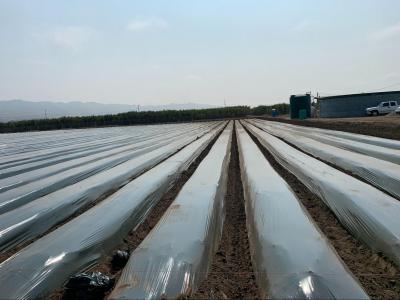There are many reasons farmers turn to plastics as a tool for more efficient growing. Plastic hoop houses, drip irrigation tape, fumigation film and polyethylene mulch films are workhorses when it comes to preventing weed growth, retaining moisture, lowering pesticide use and extending growing seasons, all with the ultimate goal of increasing growers’ yields. But the range of benefits provided by this type of “plasticulture” also comes with a downside — too much of it is finding its way into nearby oceans and streams.
In California’s Monterey County alone, an estimated 7.9 million pounds of plastic mulch and fumigation film are used each year and have become the primary source of plastic found on creek banks that feed into the Monterey Bay National Marine Sanctuary where microplastics have been found in all depths of the water column, including deep in the marine canyon.
With the help of over $2.7 million in new funding from the NOAA-National Sea Grant Infrastructure Investment and Jobs Act Marine Debris Challenge Competition, California Sea Grant and California Marine Sanctuary Foundation are aiming to significantly reduce this type of ag plastic pollution from reaching nearby waterways.

“California has been a leader in collaborative ocean litter solutions for over 15 years, but some industries, such as farming, have not been broadly looped into the conversation because the links between inland plastics use and marine debris are just starting to be realized,” says Theresa Talley, a California Sea Grant extension specialist.
“This project is particularly exciting because it supports a unique team of people from agriculture, engineering, science and conservation who are working together to develop and test innovative, feasible, effective and urgently needed end-of-life solutions for plastic waste that is generated by our farming industry.”
Researchers alongside industry partners, including Flipping Iron, Andros Engineering and leading berry companies, will seek ways to reduce the amount of macro- and microplastics left behind in the soil, and will identify plastic end-of-life solutions for growers, including those who farm on less than 100 acres.
“In California, there are about 41,000 acres of planted strawberries alone, most of which are covered with plastic mulch. Many are located in open fields near coastal areas,” says Jazmine Mejia-Muñoz, water quality program coordinator at California Marine Sanctuary Foundation for the Monterey Bay National Marine Sanctuary.

Agricultural plastics are particularly vulnerable to breakage from weather exposure and mechanical forces, making it easier for bits to find their way to waterways, adding to the threat of significant plastic pollution even in waters deemed as sanctuaries. Contaminants, such as soil clinging to farm-use plastics, have also made ag recycling a significant challenge.
“With the help of this funding and collaborative support, we’ll be tackling the main barriers that make this type of plastic so difficult to recycle and we’ll be working to create a commercially scalable solution,” says Mejia-Muñoz.
NOAA provides funding to Sea Grant institutions to increase the understanding, assessment, development, management, utilization and conservation of the nation’s ocean, coastal and Great Lakes resources. NOAA provides assistance to promote a strong educational base, responsive research and training activities, broad and prompt dissemination of knowledge and techniques, and multidisciplinary approaches to environmental problems in accordance with 33 USC 1121(b).
About California Sea Grant
NOAA’s California Sea Grant College Program funds marine research, education and outreach throughout California. Headquartered at Scripps Institution of Oceanography at the University of California San Diego, California Sea Grant is one of 34 Sea Grant programs in the National Oceanic and Atmospheric Administration (NOAA), U.S. Department of Commerce.